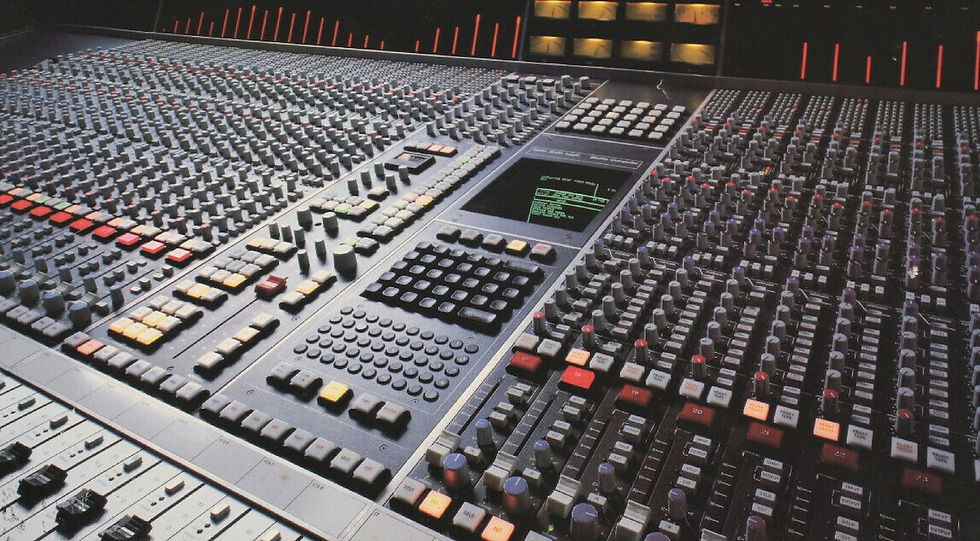The Hybrid Revolution: How Brickface Studios Marries Vintage Warmth with Digital Precision
- Brick Face
- Jun 21
- 4 min read

For decades, professional recording demanded million-dollar consoles, tape machines requiring surgical precision, and acoustic spaces few could afford. Today, that landscape has transformed — not by abandoning analog’s soul, but by fusing it with digital’s power. At Brickface Studios, we’ve pioneered this hybrid approach, leveraging tools like the Warm Audio WA12 MKII preamp for transformer-driven grit and the Presonus StudioLive AR16c for seamless digital workflow. Here’s how we honor recording’s legacy while empowering today’s creators.
The Analog Golden Age: Where Limitations Birthed Magic
The 1960s–1990s defined recording’s "character era":
- Tape’s Organic Compression: Magnetic tape saturated pleasingly when pushed, subtly compressing transients and gluing tracks. Albums from The Eagles to Prince were built on this vibe — but editing required razor blades and perfect takes .
- Console as Instrument: Solid State Logic’s E Series consoles (like the 1979 SL 4000) colored signals with harmonic weight. Their "bent board" distortion became a sonic signature — but recall meant scribbling settings on paper .
- The Cost of Magic: A single Neve 1073 preamp cost $3,000+. Studios needed $500/month just for tape .

The Digital Shift: Freedom, Precision & New Challenges
The 2000s democratized recording but risked sterility:
- DAWs Demolished Boundaries: Pro Tools replaced razor blades with non-destructive editing. Suddenly, home studios could comp vocals or quantize drums — but "clean" interfaces often lacked harmonic depth .
- Plugin Revolution: Emulations like Universal Audio’s UAD plugins recreated $50,000 gear chains in software. Yet without analog front-end warmth, tracks sometimes felt thin or clinical .
- The Hybrid Awakening: Engineers realized: digital excelled at editing; analog excelled at vibe. The fusion began.
Brickface Studios’ Hybrid Engine: WA12 MKII + AR16c
Our signal chain merges eras intentionally:
Analog Soul: The Warm Audio WA12 MKII
Inspired by API’s legendary 312 preamps, this unit injects "expensive" character at the source:
- Transformer-Driven Harmonics: Custom Cinemag USA transformers (like those in vintage API desks) add weight to vocals and "grit" to guitars. Unlike sterile digital preamps, the WA12 MKII colors signals musically — driving its gain stage creates "mild saturation [that’s] subtle but pleasing to the ear" .
- Impedance Magic: The "Tone" button switches input impedance from 600Ω to 150Ω. On ribbon mics or bass DI, this shifts frequency response — adding "air" or tightening lows without EQ .
- 71dB of Gain: Enough to power demanding ribbon mics (like a Royer R-121) while retaining low noise .
- Real-World Impact: Tracking drums through WA12 MKII preamps? Expect "punchy, pounding" kick/snare . Recording vocals? They sit "on-top of the mix with clarity" .
Digital Nervous System: Presonus StudioLive AR16c
This hub bridges analog warmth with modern flexibility:
- Hybrid Workflow: Tracks colored by WA12 MKII preamps feed into the AR16c’s 24-bit/96kHz converters. Its 18-track USB recording captures full bands .
- Zero-Latency Monitoring: Onboard DSP runs effects during tracking (e.g., reverb for vocalists).
- Studio One Integration: Multitrack sessions flow into Presonus’ DAW for comping, Melodyne tuning, and SSL channel-strip plugin processing.

The Workflow: Vintage Vibe, Modern Efficiency
Case Study: Tracking an Indie Rock Album
1. Drums:
- Close mics → WA12 MKII preamps (driven for saturation) → AR16c → Studio One
- Result: "Punchy, pounding" shells with tape-like glue .
2. Bass:
- DI → WA12 MKII’s Hi-Z input → "Tone" button engaged (150Ω for midrange growl)
- Result: "Tight, deep" lows needing minimal mixing .
3. Vocals:
- Neumann U87 → WA12 MKII (impedance set for "sheen") → UAD 1176 plugin (near-zero latency via AR16c)
- Result: "Up-front lead vocals" cutting through dense mixes .
Why Hybrid Wins
1. Sonic Depth Meets Recallability:
- Analog: WA12 MKII’s transformers impart nonlinear "mojo" that plugins can’t fully replicate .
- Digital: Save/recall every AR16c setting or Studio One edit instantly.
2. Cost Efficiency:
- Tracking through a $399 WA12 MKII delivers Neve/API-style tone at 10% the cost .
3. Creative Freedom:
- Print WA12 MKII saturation at tracking while using AR16c’s onboard effects for artist inspiration.
> "Modern recording isn’t analog vs. digital — it’s about using each to elevate the other. At Brickface, the WA12 MKII is the heart; the AR16c is the brain."
> — Vuyani Foba, Lead Engineer, Brickface Studios
The Future: Where We’re Headed
- Analog Emulation 2.0: Pairing WA12 MKII’s hardware saturation with AI-powered plugins (like iZotope Tonal Balance).
- Remote Collaboration: Artists track through WA12 MKIIs at home; stems sync via AR16c’s cloud integration.
- Preservation: Digitizing clients’ vintage tape reels through WA12 MKII’s Cinemag transformers.
Experience the Evolution
Brickface offers tailored hybrid sessions:
- "Analog First" Tracking: Drums/vocals through WA12 MKII → AR16c multitrack.
- Hybrid Mixing: Summing through analog bus processors (e.g., Warm Audio BUS-COMP) with digital automation.
- Producer Packages: Loaner WA12 MKII units for home tracking + studio mixing.
> Gear Tip: Drive the WA12 MKII’s gain high (+60dB) and attenuate its output for harmonic "hair" .
Ready to fuse vintage vibe with modern workflow?
© 2025 Brickface Studios
Where Transformers Meet Transcoding
> Featured Gear:
> - Warm Audio WA12 MKII: $399 | API-style preamp w/ Cinemag transformers
> - Presonus StudioLive AR16c: $629 | 18-track USB mixer/interface
.png)



Comments